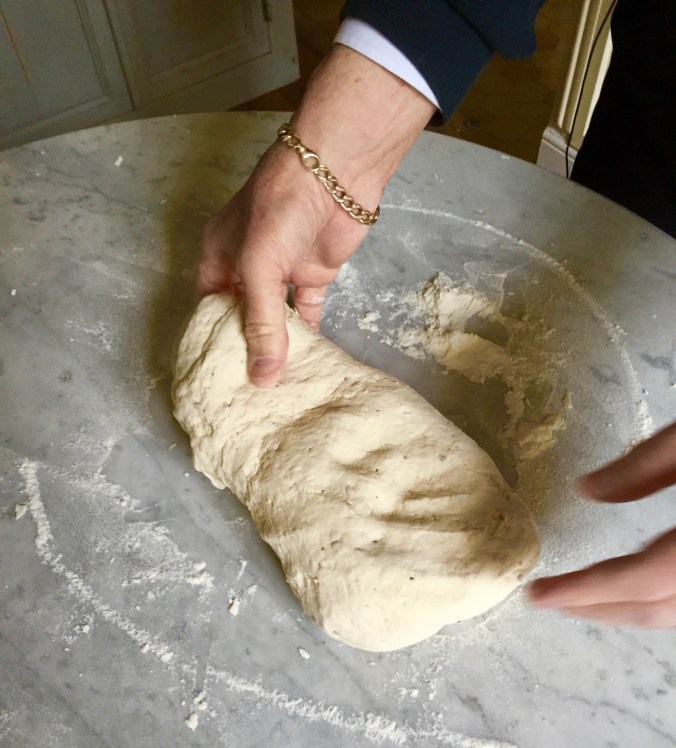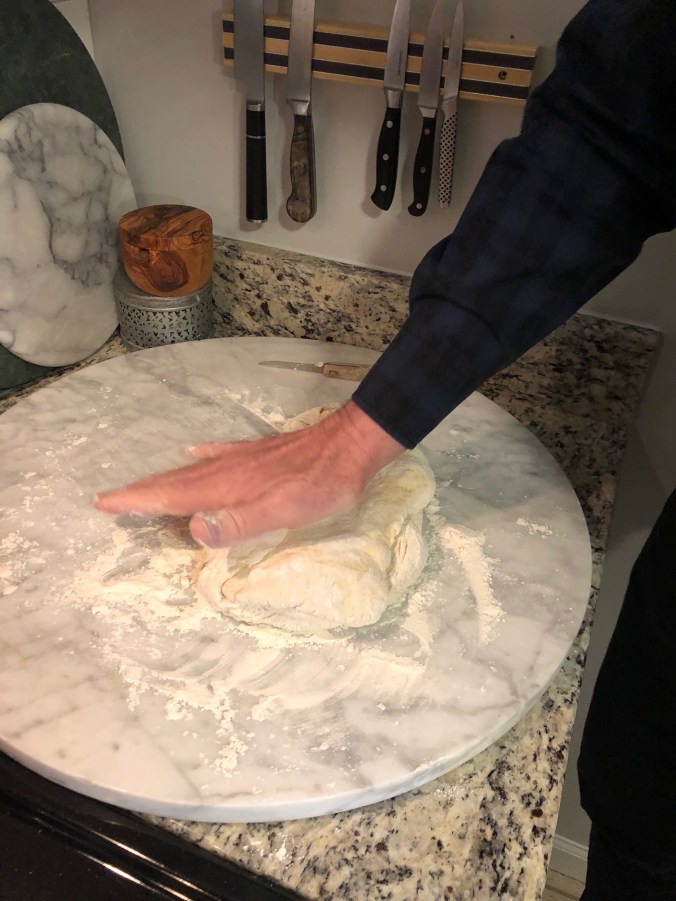Naples, Italy is the birthplace of pizza. When tomato was added to flat bread in the late 18th century, pizza, as we know it today, was born. If you go to Naples, you will certainly enjoy eating pizza on a cobblestoned street after touring the Amalfi coast and the dusty excavations in Pompeii. Then fly out the next day. Naples is not an easy city.

Pizza ranks high as a favorite food all over the world. You can order in, carry out, or enjoy at your neighborhood spot. However, I don’t eat restaurant pizza anymore, except in Italy, because my husband learned to make perfect pizza dough at home. His finesse began with a friendship of mine.
My husband enjoys creative time in the kitchen. Not everyday. But when people come to our home he will go to finicky recipe extremes. I call it performance cooking. Guests love it. Each course is beautifully plated and presented with a detailed description of what goes into whatever is being served.
His foray into kitchen time began when we lived in Taiwan. Home dinner parties were an almost every weekend event. This, in contrast to meeting up with friends in fluorescent lit, Formica tabled, disposable chopstick, plastic plate restaurants circa 1990s.
We did that often, as well, because the food in Taiwan is fresh and delicious. However, it wasn’t a place for long, conversation filled evenings with good wine and food, heavy china, linen napkins, and candles flickering down the middle of the table.
One of our family rituals while the children were growing up was to have a formal Sunday night dinner. Husband was in charge of menu planning, shopping and meal prep. I laid the table with the “fancier” china and flatware. Son and daughter were on cleanup and some form of “presentation” as entertainment. Those responsibilities worked some of the time.
My friend, Linda, is a Midwestern ex-pat who moved to Taipei with her family several years after our arrival. We became fast friends with husbands and children joining in. Linda’s Sunday night family ritual was making homemade pizza. Her youngest daughter liked to participate by carefully rolling out the dough, just so. Her two teenagers showed up for the eating part.
When she made pizza for guests, I discovered my favorite Linda-topping-recipe. It was always this: the thinnest crust, basil pesto sauce, toasted pine nuts, sliced garlic and fresh chili peppers with grated Parmesan cheese over the top.
Along the way, a quirky tweak was added to her recipe because of an Italian chef named Max, who found himself temporarily employed in a Taipei restaurant. He left Barbados for one year while the hotel where he worked was being renovated. What he loved about the Caribbean was the warm, turquoise colored water and beautiful beaches. Max found Taiwan on a map and saw it was an island, too. He thought he could happily cook and still be near sand and water. That didn’t exactly work out. Not much white sand and blue water in Taipei.
Max enjoyed chatting up lingering late night restaurant customers after the kitchen closed. When Linda mentioned she often made pizza from scratch at home, he told her the secret for the “best pizza dough”. It was a tip from his Italian mama.
Don’t add salt right away. Wait at least 20 minutes to let the yeast, sugar and warm water begin their bubbly reaction. Yeast reacts better without salt added until later. It creates more pliable and elastic dough. From a mother in an Italian village, to a beach loving chef in Taiwan, to an American home cook, here was insider pizza chemistry.
Before Linda left Taiwan, I wrote down her dough recipe with Max’s tweak. I’m the basic kind of cook rather than the finicky kind, so it was filed away and several years went by. Children left home. A new job with new geography moved us out of Asia.
With only two at the table, formal Sunday dinners faded away. We ate out more often because it was Europe! Germany! Restaurant atmosphere was charming. And the food didn’t disappoint.
Sundays in Germany are quiet. Everything closes from Saturday afternoon until Monday morning. Pulling out Linda’s recipe, I waved it in front of my husband and suggested, “We need a new Sunday eating ritual. I love Linda’s pizza. Why don’t you learn to make it?”
And so, my man began kneading and punching and creating homemade dough with puffs of flour in the air and a rolling pin in hand. Sunday night became Pizza Night. It worked when there was just the two of us. It worked as a night for entertaining guests. It worked as a Christmas Eve meal for a crowd.


From rustic Naples centuries ago, to an ex-pat friendship in Taiwan, to a displaced Italian chef and his mother, to a man who found contentment in mixing flour, water, yeast and salt into elastic dough, a new family tradition was formed. Linda’s pizza became ours.
We have made it for family, and for people from cultures around the world. In whatever geography we find ourselves, and in the midst of complexity and the rush of life, we always wait twenty minutes. And then add salt.
MARK’S PIZZA CRUST
Yield: 4, 15-inch or 6, 12-inch pizzas
![the basics–flour, water, yeast, sugar [not pictured], and salt](https://atasteofmind.com/wp-content/uploads/2019/05/img_1101.jpg?w=676)
Ingredients:
- 2 packages active dry yeast
- 1 t. sugar
- 2 C. semolina flour–mix in first [optional, but a good Italian touch]
- 3 C. all purpose flour, plus more for kneading
- 2 t. salt
- Olive oil for coating bowl as dough rises and for pizza pans
Preparation:
- Place 2 C. warm water [110-115 degrees F.] in small mixing bowl.
- Stir in 1 t. sugar. Then sprinkle in yeast. Stir to combine.
- Set aside for at least 20 minutes, letting it expand and bubble.
- After 20 minutes, combine flours, salt and yeast mixture in a large bowl. If using semolina flour, stir in first, then add the rest.
- When dough becomes difficult to stir with a wooden spoon, turn out of bowl onto a lightly floured smooth surface.
- Begin kneading by hand. Add small amounts of flour, as needed, so dough is not sticking to hands and surface.
- Knead at least 10 minutes, squeezing and folding dough over on itself, pushing with heels of both hands. I like to pick the dough up and throw it down hard onto kneading surface several times. Husband likes punching it.
- When dough becomes smooth and elastic, form into a ball.
- Lightly wipe a large bowl with olive oil. Place dough in bowl. Turn once to coat both sides in oil. Cover with a clean kitchen towel.
- Set aside to rise 45 min. to an hour or until doubled in bulk.
- Punch down, reshape dough, and cover. Let it rise once or twice more as you wish. It’s not necessary to do multiple risings, but time gives more structure and flavor to the dough.
- Preheat oven to 465 degrees F.
- Wipe or spray pizza pans lightly with olive oil. Optional to sprinkle pans with semolina flour.
- Roll out sections of dough as thinly as possible to fit prepared pans.
- Arrange toppings on dough. Less is more with homemade pizza. This keeps crust from becoming soggy and heavy.
- Bake in preheated oven to desired doneness. Start checking at 10-12 min. Watch the edges so they don’t get too brown.
- Remove from pans and cut into slices. Kitchen scissors work great.
Toppings:
- Unlimited variety
- Individual preferences rule
- Allow guests to create their own pizza topping combination
Toppings and Sauce suggestions: light brushing of red pesto, basil pesto, tomato sauce or olive oil over unbaked dough
- Thinly sliced [or diced] garlic cloves–always
- Red pepper flakes or sliced fresh chili peppers–optional
- Meat–chicken, prosciutto, pepperoni, sausage
- Or no meat
- Roasted vegetables such as eggplant, broccoli or cauliflower
- Raw veggies like sweet peppers, mushrooms, black olives, onions or shallots
- Toasted pine nuts
- Anything else


Cheese:
- I like freshly grated Parmesan, only, over top of ingredients.
- Husband mixes a little fresh buffalo mozzarella, or goat cheese, or mixed grated cheeses with a topping of Parmesan.
Final Flourish:
- Fresh arugula or baby spinach strewn over cooked pizza adds a bite of salad and green. Add before serving or let people help themselves table side.
- Champagne is our pizza beverage of choice. There is some kind of chemistry going on there too. In your home, family choice rules.


Final Note:
- Practice makes perfect. Play with proportions until you are comfortable with the sequence of steps. You won’t need a recipe if you make it regularly.
- This makes a LOT of dough, which is efficient for later use.
- It freezes well in zip lock bags and thaws easily. Place in refrigerator overnight or on the countertop until soft.
- Roll out on lightly floured surface and proceed with toppings.
- Make friends and family happy! Pizza night!


















So glad we were recipients of both the pizza and the champagne. But the company topped them both!
LikeLike
Shared company is a kind of topping, too. The admiration is mutual when we have you at our dining table…
LikeLike
Yum!! Let’s share some pizza asap.
LikeLike
Considering the trials and complexity (as you rightly observe) that life brings–always a good idea to bring pizza to the table. And the circular shape of pizza can and should mean there is always enough to go around–like the love of family and friends. Keep writing Wendy!
LikeLike